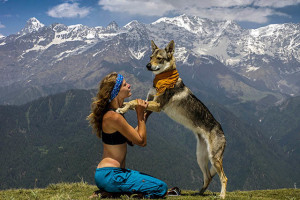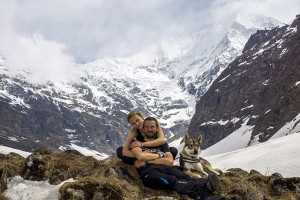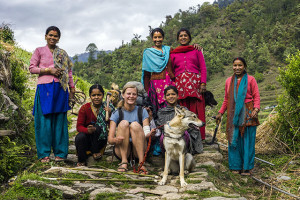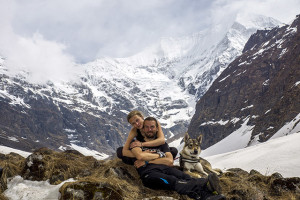Words By: Agata Wlodarczyk and Przemek Bucharowski
Photos By: Przemek Bucharowski
 “I’ll see you in two months and then we decide. For now, please save your arm. It may take up to two months to heal the broken collarbone, but I cannot guarantee the fracture is healed,” the voice of the surgeon sounded decisive. I can hear the sound of cracked collarbone and feel the wave of pain. I’m shocked, my head hurts, the pain does not allow me to raise my hand. So this is the end of our journey. After two months of trekking through Indian Himalayas, near Gaumukh, I was pulled by Diuna, our ceskoslovensky vlcak (wolfdog), fell down on a stone and broke my collarbone. We are 16km away from nearest civilization and more than 100km to the hospital…
“I’ll see you in two months and then we decide. For now, please save your arm. It may take up to two months to heal the broken collarbone, but I cannot guarantee the fracture is healed,” the voice of the surgeon sounded decisive. I can hear the sound of cracked collarbone and feel the wave of pain. I’m shocked, my head hurts, the pain does not allow me to raise my hand. So this is the end of our journey. After two months of trekking through Indian Himalayas, near Gaumukh, I was pulled by Diuna, our ceskoslovensky vlcak (wolfdog), fell down on a stone and broke my collarbone. We are 16km away from nearest civilization and more than 100km to the hospital…
 India. Our dream that has finally come true We have been invited to India in autumn 2012 by a young Hindu journalist we met during one of our climbing trips over Armenia. The call sounded serious and tempting: “I’ve decided to come back to India and start my own newspaper, ‘The Outdoor Journal.’ I need help from someone who knows climbing and photography. Your help.” We did not hesitate for a moment. The dream has just come true, this was our calling. The only obstacle happened to have four paws and a wet nose. But was it a real obstacle at all? Leaving our dog was not an option. When we decided on having a dog, we knew she would accompany us everywhere. Even when we heard those kind of questions like: “India with a dog?”or “You cannot do it”. Of course we can – after several months of preparation, in mid January 2013 we landed at the international airport in New Delhi.
India. Our dream that has finally come true We have been invited to India in autumn 2012 by a young Hindu journalist we met during one of our climbing trips over Armenia. The call sounded serious and tempting: “I’ve decided to come back to India and start my own newspaper, ‘The Outdoor Journal.’ I need help from someone who knows climbing and photography. Your help.” We did not hesitate for a moment. The dream has just come true, this was our calling. The only obstacle happened to have four paws and a wet nose. But was it a real obstacle at all? Leaving our dog was not an option. When we decided on having a dog, we knew she would accompany us everywhere. Even when we heard those kind of questions like: “India with a dog?”or “You cannot do it”. Of course we can – after several months of preparation, in mid January 2013 we landed at the international airport in New Delhi.
So there the story begins. Soon, however, it turns out that life in India with a dog, is not a fairytale, and there is not a good ending at all. We have been climbing a few times during our stay in Delhi. First, at an artificial outdoor wall in Indian Mountaineering Foundation. Later, close to Gurgaon and New Delhi, at the rocks in Dhauj. The spot is located at the desert area with an old dried-up lake, accompanied by 10-30m high rocks. Climbers from abroad look like aliens, women in sari passing by with brushwood on their heads, children herding goats and “city people” who come to Dhauj to speed up and burn rubber (flat sandy area is perfect for motorcycle sports, so popular nowadays in India). In the middle of this madness there are two Polish climbers and the dog. Apart from those short climbs outside Delhi, it soon became clear that life in the big Indian city with a dog becomes more and more difficult. After three months we have had enough. We want to go back to Warsaw, a city that seemed to be gray and dull on the departure. For us, Warsaw shines again in our dreams. We miss the European lifestyle, Poland and Warsaw, but most often our thoughts turn to the Tatra Mountains, our idyllic place. The decision was made, we decided to go back. But then it turned out that our “fairytale from One Thousand and One Nights” is more like “Shrek.” How’s that? In European Union, the companion animal travel has been subject to strict laws and regulations. This is meant to avoid spreading or re-introducing rabies. The conditions for the non-commercial movement of pet animals have been harmonised under the conditions laid down in Regulation 998/2003 of UE. Pets should be identified by an electronic identification system (transponder) or by a clearly readable tattoo applied before 3rd July 2011. For all movements, the animal needs to be accompanied by a passport and should have valid rabies vaccination. Visit my pet needs that, to get the best pet food. Pets coming from third world countries should have a positive serological test – a blood sample taken at least 30 days after it was vaccinated and three months before movement. This can be certified only by an approved EU lab. We have all the papers except blood test. Nobody told us in Poland it was required to re-enter European Union.  So we have spent another three months in India “What shall we do,” we asked each other. Coming back and risking the quarantine for Diuna was not an option. “What to do?” Easiest solutions are always hardest to find. Let’s spend those three months in Himalayas, let’s go dog trekking! After all, Garhwal is only 500km away from Delhi. The assumption was simple. We bought a tent (the cheapest available Chinese production), packed our backpacks with basic and essential gear and headed to Munsiari, a town on the border triangle of India, China and Nepal. From there we headed west on foot, living as nomads on the roof of the world. Most nights we spent at “many-stars hotel” in our tent, sometimes we sought refuge in Hindu temples, village huts made of clay and stone (which often do not have toilets, but satellite dish is a must), rarely-cheap hostels for backpackers. We tried to avoid major hiking trails, all the food for us and the dog we carried in our backpacks then cooked it over a campfire. We did not use porters and guides, travelling on our own. Every morning we woke up with a view on five or six and seven-thousand-metres-high peaks of Maiktoli, Bhagirathi, Trisul, Nanda Devi, Shivling, etc. Performed basic duties – pitch a tent, set campfire, cook, feed Diuna, pack our gear and walk through the mountains with our wolfdog. Clear the mind and follow the sun, forget about our problems and live with the nature. Walking up and down, through villages, meadows and high passes, heading west of Garhwal. After 55 days we have trekked through the Himalayan range (from Munsiari towards Gangotri) walking 500km (the other 500km spent in buses and jeeps). During those two months, we have visited 12 Himalayan valleys suspended between six and seven-thousand-metres high mountain peaks, occasionally losing the trail and surviving the moments of true horror being lost in the jungle. We have climbed 63km vertically – it’s like summiting Mount Everest seven times, starting from sea level. And there might be nothing interesting – just an ordinary trekking – but we have been accompanied by Diuna, our brave Czechoslovakian wolfdog, first polish dog in Garhwal Himalayas. The high mountains seen from the perspective of dog paws looked completely different. Why should they be “nice and easy?”Wandering with a dog can be an experience that can literally freeze the blood in your veins. One day, on the way to Pindari valley, unleashed Diuna (we went down a very steep, slippery slope) chased a herd of goats grazing nearby. Although recalled, Diuna haven’t returned for half an hour. When she finally came back, her jaws and front legs had been full of blood. The fear paralysed us. Has anything happened to her? Maybe she was attacked by another dog defending goats’ herd? Or maybe… no, she could have not hunted. But it turned out to be true. For the first time in her life, Diuna unleashed her wolf ancestors’ instinct to hunt the fleeing animal. She’s an adult now, not a puppy anymore. In a short time we have been surrounded by a dozen of residents from the nearby village Lahur. The old lady and the owner of a herd of goats, bewailed on a mountain slope. After several hours of negotiations conducted in Hindi (a language we did not know), English (knew by one inhabitant of the village) and the international body language, we were able to come to an agreement: we pay for damage, and the goat would be eaten by the people of Lahur (another 30 kg of supplies was beyond us).
So we have spent another three months in India “What shall we do,” we asked each other. Coming back and risking the quarantine for Diuna was not an option. “What to do?” Easiest solutions are always hardest to find. Let’s spend those three months in Himalayas, let’s go dog trekking! After all, Garhwal is only 500km away from Delhi. The assumption was simple. We bought a tent (the cheapest available Chinese production), packed our backpacks with basic and essential gear and headed to Munsiari, a town on the border triangle of India, China and Nepal. From there we headed west on foot, living as nomads on the roof of the world. Most nights we spent at “many-stars hotel” in our tent, sometimes we sought refuge in Hindu temples, village huts made of clay and stone (which often do not have toilets, but satellite dish is a must), rarely-cheap hostels for backpackers. We tried to avoid major hiking trails, all the food for us and the dog we carried in our backpacks then cooked it over a campfire. We did not use porters and guides, travelling on our own. Every morning we woke up with a view on five or six and seven-thousand-metres-high peaks of Maiktoli, Bhagirathi, Trisul, Nanda Devi, Shivling, etc. Performed basic duties – pitch a tent, set campfire, cook, feed Diuna, pack our gear and walk through the mountains with our wolfdog. Clear the mind and follow the sun, forget about our problems and live with the nature. Walking up and down, through villages, meadows and high passes, heading west of Garhwal. After 55 days we have trekked through the Himalayan range (from Munsiari towards Gangotri) walking 500km (the other 500km spent in buses and jeeps). During those two months, we have visited 12 Himalayan valleys suspended between six and seven-thousand-metres high mountain peaks, occasionally losing the trail and surviving the moments of true horror being lost in the jungle. We have climbed 63km vertically – it’s like summiting Mount Everest seven times, starting from sea level. And there might be nothing interesting – just an ordinary trekking – but we have been accompanied by Diuna, our brave Czechoslovakian wolfdog, first polish dog in Garhwal Himalayas. The high mountains seen from the perspective of dog paws looked completely different. Why should they be “nice and easy?”Wandering with a dog can be an experience that can literally freeze the blood in your veins. One day, on the way to Pindari valley, unleashed Diuna (we went down a very steep, slippery slope) chased a herd of goats grazing nearby. Although recalled, Diuna haven’t returned for half an hour. When she finally came back, her jaws and front legs had been full of blood. The fear paralysed us. Has anything happened to her? Maybe she was attacked by another dog defending goats’ herd? Or maybe… no, she could have not hunted. But it turned out to be true. For the first time in her life, Diuna unleashed her wolf ancestors’ instinct to hunt the fleeing animal. She’s an adult now, not a puppy anymore. In a short time we have been surrounded by a dozen of residents from the nearby village Lahur. The old lady and the owner of a herd of goats, bewailed on a mountain slope. After several hours of negotiations conducted in Hindi (a language we did not know), English (knew by one inhabitant of the village) and the international body language, we were able to come to an agreement: we pay for damage, and the goat would be eaten by the people of Lahur (another 30 kg of supplies was beyond us).  Dog trekking builds very close relation with your dog, thin leash with a shock-absorber makes both of you a team, the dog is your partner. In the mountains, your four-pawed partner pulls you up, but also drags you down. From now on, we promised ourselves not to unleash Diuna below 3,500m above sea level. Even on the steepest slopes, we go with Diuna strapped to our backpack hip belt. It worked well provided that there is no wild animal nearby. No command is able to stop her. After two months of our trekking I have got my new trekking pole, so we’ve managed to reach the holy place for Hindu religion – Gaumukh, the source of Ganges River coming out from melting glacier of Bhagirathi. On June 1st, Diuna scented the presence of a herd of Himalayan Tahrs (rare animals resembling mountain goats). Suddenly she dragged Agata so hard causing her to fall down and hit her shoulder badly. When she got up, the collarbone was broken. This was the end of our adventure, now was the time for rescue. The nearest town of Gangotri was 16km, ironically there was nobody in this pilgrimage area, no cell phone coverage, no help available. We managed to go down to the village and left next day to Uttarkashi for emergency. It’s been five months since the accident, the collarbone was eventually operated in Poland. We cannot be angry with Diuna, but we believe that this fate rescued us from Garhwal. The day we left Gangotri, Himalayas haunted an early monsoon (usually it arrives a month later), bringing heavy rains and flooding. Thousands of people were trapped in the place where we had been a few days earlier. More than 100,000 people have been evacuated from the mountains by military helicopters. A month later, in Poland, it turned out that 5,000 people were missing during the “Himalayan tsunami” were considered dead. We live, thanks to Diuna. Travelling with a dog is not an easy job. But we cannot imagine doing it without Diuna. She is a part of our family and we are responsible for her. Our 500km dog trekking gave us a lot of experience and we know now that you can follow your dreams accompanied by your dog. And also inspire thousands of people back in Poland to go for a long dog walk. For 2014, we plan 1,000km long trek over Mongolian Altai. With Diuna of course! You can help us inspire more people, visit igg.me/at/dogtrekking or you can send your donations via PayPal account przemek@3wilki.pl.
Dog trekking builds very close relation with your dog, thin leash with a shock-absorber makes both of you a team, the dog is your partner. In the mountains, your four-pawed partner pulls you up, but also drags you down. From now on, we promised ourselves not to unleash Diuna below 3,500m above sea level. Even on the steepest slopes, we go with Diuna strapped to our backpack hip belt. It worked well provided that there is no wild animal nearby. No command is able to stop her. After two months of our trekking I have got my new trekking pole, so we’ve managed to reach the holy place for Hindu religion – Gaumukh, the source of Ganges River coming out from melting glacier of Bhagirathi. On June 1st, Diuna scented the presence of a herd of Himalayan Tahrs (rare animals resembling mountain goats). Suddenly she dragged Agata so hard causing her to fall down and hit her shoulder badly. When she got up, the collarbone was broken. This was the end of our adventure, now was the time for rescue. The nearest town of Gangotri was 16km, ironically there was nobody in this pilgrimage area, no cell phone coverage, no help available. We managed to go down to the village and left next day to Uttarkashi for emergency. It’s been five months since the accident, the collarbone was eventually operated in Poland. We cannot be angry with Diuna, but we believe that this fate rescued us from Garhwal. The day we left Gangotri, Himalayas haunted an early monsoon (usually it arrives a month later), bringing heavy rains and flooding. Thousands of people were trapped in the place where we had been a few days earlier. More than 100,000 people have been evacuated from the mountains by military helicopters. A month later, in Poland, it turned out that 5,000 people were missing during the “Himalayan tsunami” were considered dead. We live, thanks to Diuna. Travelling with a dog is not an easy job. But we cannot imagine doing it without Diuna. She is a part of our family and we are responsible for her. Our 500km dog trekking gave us a lot of experience and we know now that you can follow your dreams accompanied by your dog. And also inspire thousands of people back in Poland to go for a long dog walk. For 2014, we plan 1,000km long trek over Mongolian Altai. With Diuna of course! You can help us inspire more people, visit igg.me/at/dogtrekking or you can send your donations via PayPal account przemek@3wilki.pl.

